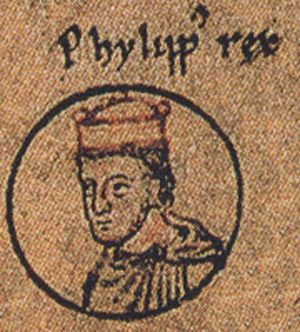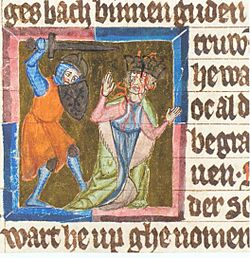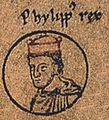Philip of Swabia facts for kids
Quick facts for kids Philip |
|
|---|---|
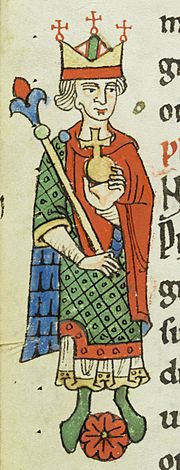
Philip of Swabia with the Imperial Regalia, miniature in the Chronicle of Weissenau Abbey, ca. 1250. Kantonsbibliothek St. Gallen (Vadiana Collection, Ms. 321, p. 40.)
|
|
| King of Germany (King of the Romans) | |
| Reign | 8 March 1198 – 21 June 1208 |
| Coronation | 8 September 1198, Mainz |
| Predecessor | Henry VI |
| Successor | Otto IV |
| Duke of Swabia | |
| Reign | 15 August 1196 – 21 June 1208 |
| Predecessor | Conrad II |
| Successor | Frederick IV |
| Born | February/March 1177 Pavia, Italy |
| Died | 21 June 1208 (aged 31) Bamberg, Franconia, Germany |
| Burial | Speyer Cathedral |
| Spouse |
Irene Angelina
(m. 1197) |
| Issue |
|
| House | Hohenstaufen |
| Father | Frederick I, Holy Roman Emperor |
| Mother | Beatrice I, Countess of Burgundy |
Philip of Swabia (born February/March 1177 – died June 21, 1208) was a powerful member of the House of Hohenstaufen. He served as King of Germany from 1198 until his death.
When Philip's older brother, Henry VI, Holy Roman Emperor, died in 1197, the Hohenstaufen family's power weakened. This created a big power struggle in the northern Alps. Henry's son, Frederick, was too young to rule. This led to two different kings being chosen in 1198. Philip of Swabia and Otto of Brunswick both claimed the throne.
For years, both Philip and Otto tried to win support from European leaders and the Pope. They used money, gifts, public events, and even military actions. Philip slowly gained more power over Otto in the northern Alps. But at the peak of his rule, he was killed in 1208. This ended the fight for the throne, and Otto quickly became the recognized king. Philip was the first German king to be murdered while he was ruling.
Contents
Life Story of Philip of Swabia
Early Life and Family
Philip was born in or near Pavia, in what was then the Imperial Kingdom of Italy. He was the tenth child and youngest surviving son of Frederick Barbarossa. His mother was Beatrice I, Countess of Burgundy. His family, the House of Hohenstaufen, was a very important noble family.
Philip was named after Philip of Cologne, a key helper of his father, Frederick Barbarossa. This showed how important the Archbishop was to the royal family.
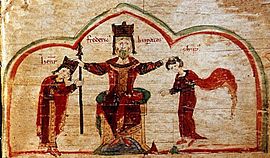
As a child, Philip was prepared to become a church leader. He learned to read and speak Latin. He studied at a monastery in Adelberg. From 1189 to 1193, he was a church leader at Aachen Cathedral. In 1190 or 1191, he was chosen as Prince-bishop of Würzburg, but he was never officially made a bishop.
In 1193, Philip decided not to pursue a church career. This might have been because his brother, Henry VI, and his wife had no children yet. Also, Philip's other three brothers had no children. However, Henry VI and his wife, Constance, later had a son, Frederick II, Holy Roman Emperor, in 1194. This son was elected King of the Romans in 1196.
To improve relations with the Byzantine Empire, Philip was engaged to Irene Angelina in 1195. She was the daughter of Emperor Isaac II. Philip and Irene married in 1197 near Augsburg. They had five daughters:
- Beatrix (1198–1212), who married Otto IV, Holy Roman Emperor.
- Maria (1199/1200–1235), who married Henry II, Duke of Brabant.
- Kunigunde (1202–1248), who married King Wenceslaus I of Bohemia.
- Elisabeth (1205–1235), who married King Ferdinand III of Castile.
- A daughter who was born and died shortly after Philip's death in 1208.
The Fight for the Throne
Beginning of the Conflict
Philip was trusted by his brother Henry VI. He was meant to look after Henry's young son, Frederick, if Henry died early. In September 1197, Philip was traveling to bring Frederick for his coronation. But he heard that Henry VI had suddenly died. Philip quickly returned to Germany.
Philip wanted to protect his nephew Frederick's interests. But things moved too fast. Some powerful princes, led by Archbishop Adolph of Cologne, decided to choose a different king. They chose Otto of Brunswick, who was a nephew of King Richard I of England.
Because many disliked the idea of a child king, Philip was chosen by his supporters to protect the empire. On March 8, 1198, Philip was elected German King in Mühlhausen. He had the important Imperial Regalia (crown, sword, and orb). However, the three main Archbishops who usually crowned the king were not there.
Otto was elected later, on June 9, 1198, in Cologne. Archbishop Adolph of Cologne, who was supposed to crown the king, crowned Otto. On July 12, 1198, Otto was crowned at the traditional royal place in Aachen. Philip, however, was crowned in Mainz Cathedral on September 8, 1198, by a different Archbishop.
This created a big problem: two kings claiming the same throne. Both sides tried to get the support of Pope Innocent III. The Pope wanted to prevent the Holy Roman Empire and the Kingdom of Sicily from being united under one ruler. He also worried about the Hohenstaufen family's claims in Italy.
The Pope saw Philip's family as "persecutors" of the church because his father, Frederick Barbarossa, had fought against the Pope for years. Otto's family, however, had always been loyal to the church. Otto also promised the Pope that he would not try to unite the Holy Roman Empire with Sicily. So, the Pope chose Otto and officially went against Philip. However, the Pope's decision did not have a big effect in the empire.
Strengthening His Rule
Both kings tried to win over undecided leaders. They did this by giving gifts, transferring land, or arranging marriages. These actions helped strengthen their alliances.
In 1199, Philip and his wife, Irene-Maria, celebrated Christmas with great splendor in Magdeburg. This was close to Otto's home. Many important nobles attended, showing their support for Philip. The event was very expensive, but it helped Philip gain fame and honor as a capable ruler. A famous poet, Walther von der Vogelweide, wrote songs about the celebration, praising Philip.
In 1201, Philip met his cousin Boniface of Montferrat, a leader of the Fourth Crusade. Philip also met his brother-in-law, Alexius Angelus, at his court. Some historians believe that Alexius convinced Boniface to redirect the Crusade to Constantinople.
Philip used marriages to strengthen his position in Germany. In 1203, he tried to arrange a marriage between one of his daughters and a nephew of Pope Innocent III. But Philip did not agree to the Pope's demands, so the marriage talks failed.
Philip was good at rewarding his loyal supporters. He attracted high-ranking supporters from Otto's side with gifts. For example, Duke Ottokar I of Bohemia became a king in 1198 for his support. Count Wilhelm II of Jülich also received valuable gifts.
In 1204, Archbishop Adolph of Cologne and Duke Henry I of Brabant switched their support to Philip. The Archbishop of Cologne was allowed to keep his important role in crowning the king and received a large sum of money. This was a major victory for Philip.
On January 6, 1205, Philip was crowned again in Aachen. This time, the Archbishop of Cologne, the rightful person to do so, performed the ceremony. This second coronation helped Philip gain more acceptance as the true king.
On July 27, 1206, Philip's army defeated an army loyal to Otto in Wassenberg. This was the only time their armies fought directly. After the battle, the two kings met in person, but they could not reach an agreement. The Pope saw that Otto was losing power and lifted his ban on Philip. By 1207, the Pope was even talking with Philip about his imperial coronation.
Philip's Court Life
The royal court was a very important place for medieval kings. It was where decisions were made, power was shown, and people gathered. Kings traveled around their kingdom to show their authority. Philip held 28 important court meetings during his reign.
About 630 people were part of Philip's court. Around 100 of them were very close to the King. Important bishops and secular princes were often at his court. The most important part of the court was the Chancery, which handled official documents.
Philip was known for having courtly poetry. The poet Walther von der Vogelweide wrote a special song about the Magdeburg Court Day in 1199, praising Philip. Philip did not have much time to promote art or build many buildings during his short reign.
Philip's Assassination
In May 1208, Philip was planning a military campaign against Otto IV. He paused his plans to attend his niece's wedding in Bamberg on June 21. After the wedding, Philip went to his private rooms. In the afternoon, he was murdered by Count Otto VIII of Wittelsbach. Otto VIII then escaped.
Historians believe the main reason for the murder was a broken marriage promise. Otto VIII was known for his unstable personality. Philip had promised his daughter Kunigunde to Otto VIII in 1203. This was to gain Otto's support against a rival. However, as Philip's power grew, he no longer needed Otto VIII's alliance. In 1207, Philip engaged Kunigunde to Wenceslaus, the son of King Ottokar I of Bohemia. This made Otto VIII feel betrayed and threatened. He swore revenge on Philip.
Philip was the first German king to be murdered since the early Middle Ages. Most medieval writers believed Otto VIII acted alone.
What Happened After Philip's Death
Philip was first buried in Bamberg Cathedral. His rival, Otto IV, made sure the assassin was hunted down to prove his own innocence. Philip's wife, Irene-Maria, who was pregnant, died two months later after a miscarriage.
After Philip's death, Otto IV quickly gained full control. He was recognized as the German monarch in November 1208 and crowned Holy Roman Emperor by Pope Innocent III the next year. Otto IV wanted to bring order back to the empire. Philip's murderer, Otto VIII of Wittelsbach, was found and killed in March 1209.
However, Otto IV soon had problems with Pope Innocent III when he tried to conquer the Kingdom of Sicily. The Pope officially went against Otto. Many princes then chose Philip's nephew, Frederick II, as a rival emperor.
In 1212, Frederick II moved to the northern part of the empire. To gain the trust of Philip's supporters, Frederick II had Philip's remains moved from Bamberg to Speyer Cathedral in 1213. Speyer Cathedral was an important burial place for German kings. By moving his uncle's body there, Frederick II strengthened his claim to the throne. Philip is the last Roman-German king to be listed in the medieval death records of Speyer Cathedral.
How Philip Was Seen in History
Many writers from Philip's time saw the conflict between the two kings as a test of divine order. One chronicler, Burchard of Ursperg, described Philip as gentle, kind, and generous. He said Otto IV lacked the important qualities of a ruler. Another writer, Arnold of Lübeck, called Philip an "ornament of virtues." The poet Walther von der Vogelweide also praised Philip as a "young and brave man."
Philip's murder did not change the overall course of the empire's history much. Later writers described the transfer of power from Philip to Otto IV as smooth. However, the experience of this power struggle led to new ways of writing down laws and customs, like the Sachsenspiegel.
Images for kids
See also
 In Spanish: Felipe de Suabia para niños
In Spanish: Felipe de Suabia para niños


